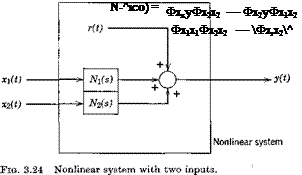SINUSOIDAL DESCRIBING FUNCTION
When a stable linear system has a sinusoidal input x — A1eiat the steady – state output y(t) after the initial transients have decayed is a sinusoid of the same frequency, and the input/output relation is given by (3.4,20). A “well-behaved” nonlinear system with such an input will have a steady-state output that is also periodic, but not sinusoidal, other harmonics being present. Whereas the input spectrum is a “spike,” the output spectrum is a “comb.” Other behavior is conceivable, but the above describes the usual situation; we assume it to be the case here. Since the mean product of sinusoids of different frequency is zero, the only Fourier component of the output that has a nonvanishing correlation Rxy with the input is the fundamental, i. e. the component that has the same frequency £1 as the input.
Since Фху is the Fourier integral of Rxy, it follows that only the fundamental component yf of у contributes to Фга. From (2.6,22) we have
ФХУі = lim – LX*(im;T)Yf(im;T)
T-+ 00 4:1
Фхх = lim — X*(ia>; Т)Х(ію; T) t-> oo 4T
The ratio (3.5,7) then leads simply to
Щісо) = (3.5,9)
Х(га>)
where Yf(ia>) and X(ia>) are the Fourier transforms of the sinusoids, given in Table 2.2. Now if these sinusoids are described by
x = АіЄг’ш; yf = A2elQt
where Ax and A2 are the complex amplitudes of the input and output fundamental, respectively, we get, using item 3, Table 2.2,
Щісо) = ^ (3.5,10)
■d-i
which is identical with the frequency-response function given by (3.5,20) provided that we regard the fundamental as the total output.
Evidently the sinusoidal describing function leads to a remnant made up of all the lower and higher harmonics of the output.
TWO-INPUT DESCRIBING FUNCTIONS
If two inputs to a nonlinear system contribute to the output y, as in Fig. 3.24 we may define two describing functions by the same principle as used
 |
|
above for one input. The method is basically the same, but the details are a little more involved. The result for Nj is
and that for N2(ico) is obtained by permuting the subscripts 1 and 2. Note that if aq and x2 are uncorrelated, so that the cross-spectral density ФХіХ2 = 0, then (3.5,11) reduces to (3.5,7), the formula for a single input.











